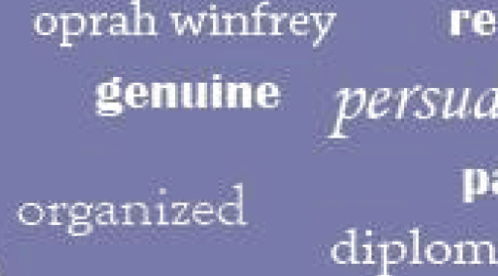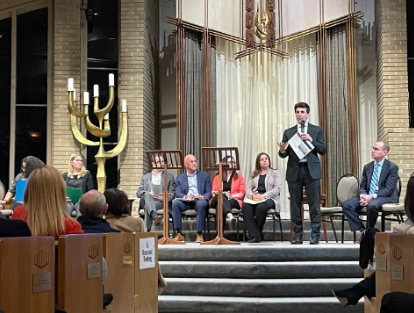
Ben Rogers ’15 hunched over his laptop, watching intently as the blue “loading” symbol made slow rotations
in the corner of the dimly lit screen. He pressed refresh on the clunky black keyboard a few times and glanced across the crowded room at his classmates whispering and giggling into their palms or fooling around on their computers. The page loaded and a list of possible professions popped up in front of him.
At first, he was apprehensive. A shy boy, Rogers had always envisioned himself pursuing a more independent career without the everyday social interaction that some other jobs require.
“At the time, I saw myself as a pretty quiet kid who really just liked math,” Rogers said.
However, at the top of the Naviance “Who Are You?” test result page, the word “teacher” stuck out to him. His first instinct was to assume the test was inaccurate. Soon after, he found he was wrong.
“Since the results of the test said that being a teacher would fit my personality, I tried tutoring children in Bridgeport,” Rogers said. “Turns out, the test was right because I had a heck of a time and was good at teaching material.”
Naviance is a college and career planning website that gives students access to information that can help them make informed decisions about their futures.
Every freshman takes the first of three Naviance assessments, the “Personality Type,” which provides students with specific information about their personality types. During sophomore year, students take the “Career Interest Profiler” and “Cluster Finder” tests. The results of the tests are used to generate lists of careers that match students’ interests.
The “Personality Type” test uses a set of questions regarding social tendencies, career preferences and other aspects of students’ lives in order to help identify personality traits and offer potential careers based off of this results. It outlines dominant characteristics in each student using a combination of four letters” extraverted or introverted (E or I), sensing or intuitive (S or N), feeling or thinking (F or T), and judging or perceiving (J or P). Students tend to lean towards one of the letters in each category over the other, giving them their code. However, everyone exhibits characteristics of both letter options, Victoria Capozzi, a guidance counselor at Staples, explains.
Students also receive information on their key characteristics, strengths, blind spots and learning type.
However, Amanda Zager ’17 also expressed that taking the test in January or February of freshman year may make it harder for students to appreciate all of its benefits. “I think students should take it in their sophomore year, in the middle of their high school experience,” Zager said.
Capozzi notes that students are constantly growing, developing, and changing as a result of maturing and life experiences. Thus, it is not uncommon for students’ personality types to change as they age.
According to Washenko, the guidance office agrees that having the ability to take the test as an older student could be beneficial.
“If students are interested in taking [the same personality test] again, they can do that to see if there’s a different picture that comes out or if maybe the scores come out differently,” Washenko said.
In order to retake the personality test, students simply have to visit their guidance counselor and ask to have their results cleared, Capozzi said.
For some students, however, changing the grade in which you take the test wouldn’t increase the credibility of their results.
“I just don’t think that it’s an accurate thing to have online. You can’t [take] a test and decide what you should do with your profession — it should be decided through trial and error. You should find a job and see if you like it or not. That’s the ultimate test,” Campbell Marsh ’16 said.
The guidance counselors recognized that the Naviance system isn’t perfect; it isn’t uncommon for students to question the validity of the tests based on their results.
“It’s great when it’s a really accurate picture, but in some cases they’re not.” Washenko said. “I think that’s just because the questions they were being asked during the assessment kind of caused the student to get lost along the way, or they didn’t take it as seriously as we would like them to, or they’re just not seeing some things about themselves.”
However, some students shared Rogers’ positive experience, and were pleasantly surprised in the accuracy of their results.
“The personality typing is very accurate and when I read it, it was scarily [similar to] how I view myself,” Simon Ginsberg ’16 said. “It is almost like it’s something I’ve written about myself.”
Naviance defined Ginsberg as an extrovert. The validity of that statement is evident upon meeting him — he has a relaxed, friendly demeanor and outgoing personality that bubbles out of him with every word he speaks.
Though this is something that is apparent in his willingness to participate during class, his personality type results affect him in situations far beyond the classroom.
“The reason we started [giving] this [assessment] is because we firmly believe that high school is about the whole student, not just the academic student,” Capozzi said.
Rogers stressed how successful the results of the Naviance test have been in guiding him through his high school career.
“I just looked back at the personality test and realized that it gave me a clear understanding of what I was good at. It recommended certain areas of study that would fit me. I decided to try [some of] these out, and have found [them] to be very interesting and right up my alley,” Rogers said.












































